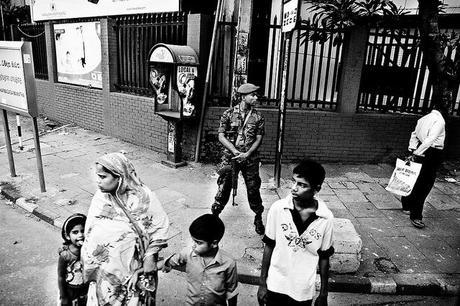
A typical street scene during 2009 in Colombo, Sri Lanka's largest city. (Photo: Biel Calderon via Flickr)
For more than 25 years, Sri Lanka had been consumed by an ongoing civil war. With the defeat of the Liberation Tigers of Tamil Eelam in 2009, Sri Lanka has turned its focus to governance and economic growth. Although the end of hostilities has brought relief, moving from war to peace has its own challenges.
One of those challenges is what to do with a military whose soldiers are no longer needed for the job they were recruited for. Sri Lanka has found plenty of tasks for them to do, everything from building bridges and houses to selling vegetables and operating an air-ticketing agency. The military can be a capable institution, but relying too heavily on the military can prevent the development of other institutions necessary for a healthy, functioning democracy. Whether its managing government services, or running businesses, turning to the military should be a last resort.
For many countries, the temptation to employ the army for roles beyond defense is too much to resist. Militaries tend to be highly structured and efficient organizations. In a country with few or weak institutions, the military is often the one institution seen as able to ‘get things done.’ But turning to the military to solve non-military problems can be perilous. Once the military starts taking on additional roles, it can be hard to stop.
Sri Lanka would be wise to study the role the military plays among its neighbors. With Bangladesh’s democratic government mired in corruption, the military stepped in to form a caretaker government in 2006. Although largely welcomed as a stabilizing force, the caretaker government was no better at overcoming Bangladesh’s challenges, and created problems of their own. According to the International Crisis Group:
In its first year in power, the government made some 440,000 arrests ostensibly linked to its anti-corruption drive, creating a climate of fear in the country. Its poor handling of the economy and natural disasters has aggravated underlying scepticism over its real intentions. The continued state of emergency and efforts to undermine popular politicians and split their parties have left many questioning its sincerity.
Elections were held in 2008 and Bangladesh returned to civilian rule. Bangladesh has regularly topped the list of most corrupt countries. Desperate for a solution, the caretaker government offered a glimmer of hope. Fighting corruption requires institutional changes that remove the incentives for corruption in the first place. The military proved capable at arresting anyone suspected of corruption, but was wholly unable to enact the institutional changes necessary.
Pakistan faces its own challenges with its military. Although no longer a military government, the military is still the dominant player, bringing in billions of dollars in foreign assistance, not to mention its vast businesses with $10 billion in assets. In total, Pakistan’s military businesses make up over 7 percent of GDP. But is the military contributing? In her book, “The Military Inc: Inside Pakistan’s Military Economy,” Dr. Ayesha Siddiqa Agha finds that many of the Pakistan military’s businesses are operating at a loss, propped up by the government. These businesses crowd out more legitimate private businesses and dry up resources that could be used more efficiently. But taking away support from an institution like the military is no easy task.
In many countries, the military is a highly respected institution, often viewed as bound by honor and above partisanship. When a country is facing challenges, it can be easy to look to the military to solve them. But tasking the military with duties beyond defense invites new challenges. Militaries are not designed for such tasks, and however well intentioned, they will likely fail.

